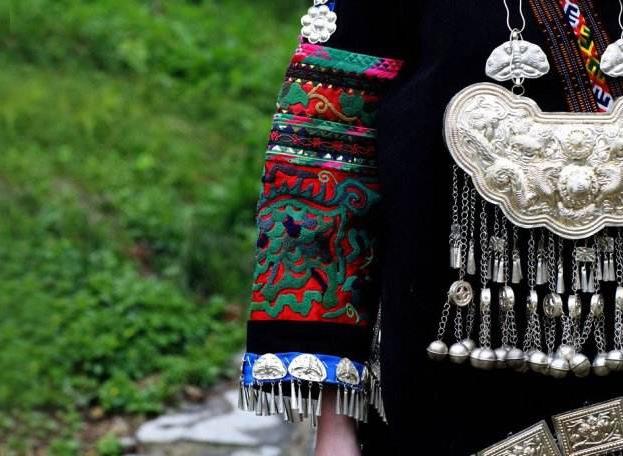A remote mountain village with a silver lining
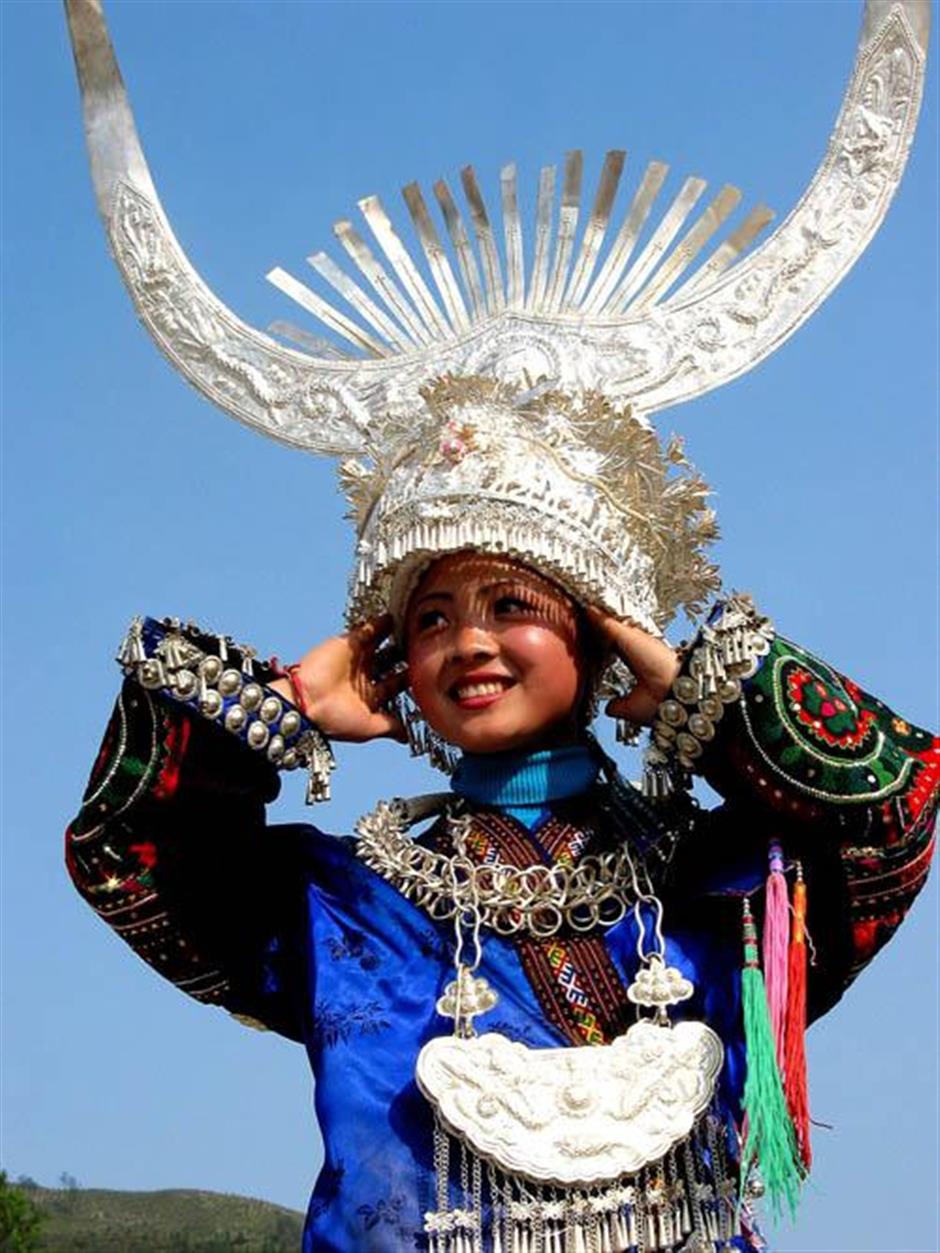
A Miao woman sports silver ornaments and accessories.
Remote, mountainous and off the beaten track, Kongbai in Guizhou Province is known as the “village of silversmiths.”
The craft of making silver headdresses, earrings, necklaces, bracelets, belts and other garment accessories has been handed down for centuries and is etched in the cultural customs of the Miao ethnic minority of the village.
“I met my wife when she was dancing at a local festival,” says Yang Guangxue, a local silversmith. “I noticed her silver ornaments before I even looked upon her pretty face.”
In its heyday, Kongbai boasted hundreds of silversmiths, but entering the 1990s, many left to go outside to find more lucrative jobs. Few silversmiths remain, but silver still plays a large part in the traditional dress and ancient customs of villagers.
Kongbai covers about 9 square kilometers on a mountainside in the town of Xijiang, Leishan County. According to the Chinese Academy of Social Sciences, there were 414 silversmiths either living in or originally hailing from the village in 2009.
Among those who remain today is Long Taiyang, who did try his luck in a shoe factory in Shenzhen, Guangdong Province, for a bit before returning to his hometown.
Long has established his own jewelry business and opened a private museum featuring Miao silver ornaments. The decision to remain loyal to his ancestry has paid off. He makes a comfortable living. The museum had 14,200 visitors in 2017, and 9,700 of them enrolled in the jewelry-making workshop.
“I always have had a strong desire to promote and preserve our culture, especially Miao silver ornaments,” says Long. “I keep hoping that more of those who have left the village will return and find career opportunities here.”

The wooden houses of the Miao nestle against hillsides in Kongbai Village.
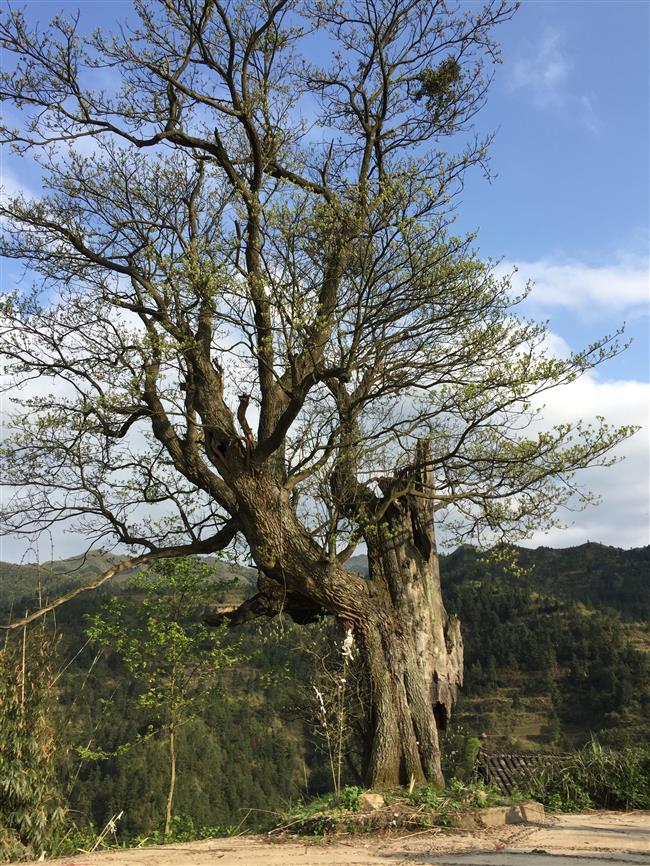
The nearly 500-year-old tree is the only survivor of a 1735 fire.
The village is not easily accessible, which helps explain its escape from modern tourist commercialism. To get there from Shanghai requires plane, rail and bus trips, and finally a hired car through rugged terrain.
Ever the enterprising businessman, silversmith Long operates a shuttle service between Kongbai and Xijiang, an hour’s drive away. Xijiang is the largest Miao settlement in the world and bears the title “thousand household village.” It is a popular tourist destination.
In contrast to Xijiang’s 5,000 residents, Kongbai has 1,234 registered residents, according to Li Jun, the administrative head of Kongbai.
The most prevalent surnames are Li, Mu, Long, Yang and Pan. These clans maintain certain marital traditions dictated by surname. Those named Li and Mu cannot intermarry. Ditto the Longs and the Yangs. But the Pans can marry anyone they want.
The village has a vivid past. In 1735, the Qing Dynasty (1644-1911) army invaded the area and burned the village to the ground. Local resistance fighters were beheaded and their heads hung from a tree. Today, the site is still worshipped in annual rituals honoring ancestors.
The village chief, locally called Guzangtou, took me to visit an almost 500-year-old tree, the lone survivor of the fire. The tree is revered by locals, who hold their annual Lusheng Festival in the square surrounding it.
The Miao people are passionate and tribal in their customs. They congregate for what is known as the “long-table banquet” to celebrate big events, like Spring Festival or weddings. The feasts attract hundreds, or even thousands, of guests, including tourists who may be in the area.
The party of traditional Miao dishes includes hot and sour fish soup, preserved ham, colorful sticky rice and rice wine. Visitors who can’t tolerate extremely spicy food should pack a few snacks along to stave off hunger pangs.
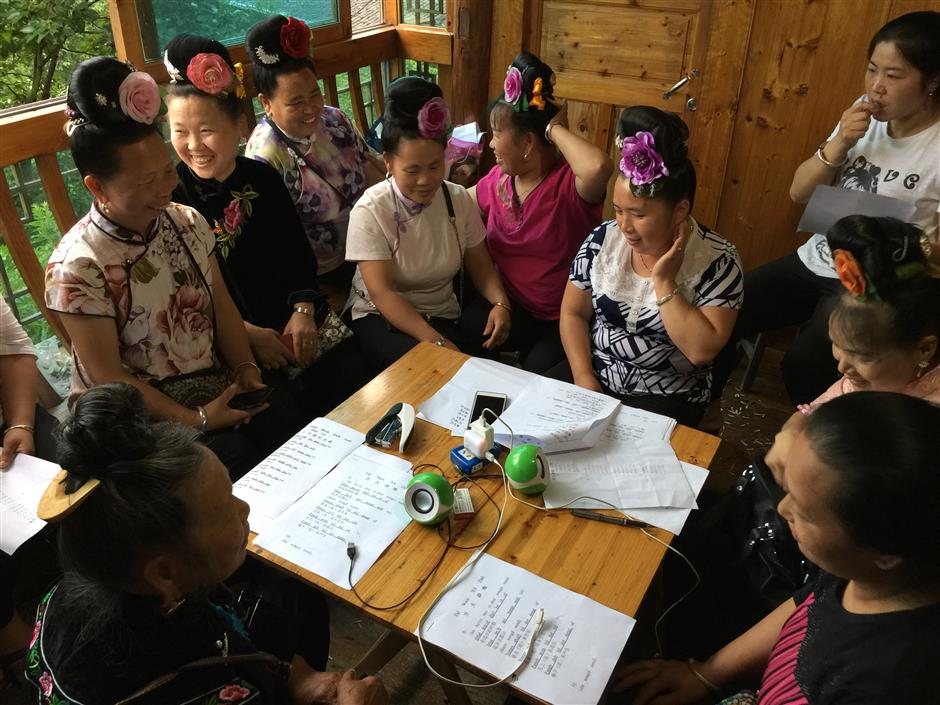
Miao women, wearing flowers in their hair, sing folk songs together.
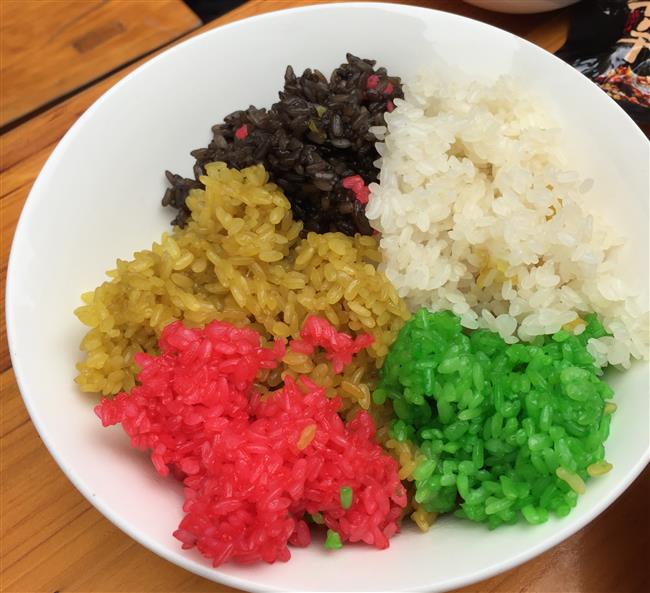
The colorful sticky rice
Women play a primary role in the daily life of the village. They farm, clean, cook, nurse and embroider, often working together in merry groups.
One day as I was walking along a cobblestone road, I heard beautiful singing. Intrigued, I quietly slipped into a wood house nearby. There, about 20 women, adorned with silver ornaments and flowers in their hair, were sitting around a table singing folk songs.
“In our group, every woman has long hair,” says one of the women who is in her 70s. “Without that, it would be impossible to wear flowers and silver hair accessories in our hair, and then women would not look as pretty.”
In the surrounding paddy fields, farmers use bamboo baskets without bottoms to trap fish cultivated there. The fish are locally call daotian, and they provide both food for the table and a source of outside income.
During my two-week stay, I was warmly welcomed by the village chief and his family. Their wooden home had neither Wi-Fi nor air conditioning, but the local people don’t seem bothered by the lack of modern amenities. Theirs is a tranquil lifestyle built on community values and long-held customs.
Like the majority of men in the village, Guzangtou is also a silversmith. The role of village chief was once spiritual as well as administrative. Nowadays, administration lies in the hands of a village committee, but Guzangtou still commands respect in the village.
Despite its demise over the years, silversmithing remains the largest source of village income. In most cases, the silversmiths in Kongbai make silver ornaments to order, rather than mass-producing them. Some of the products are exported overseas.
Silver ornaments are intertwined with local religion and traditions. Traditionally, the wearing of silver accessories was thought by the Miao people to ward off evil spirits and disease.
Xiaoxiao, daughter of the village chief, showed me her mother’s silver ornaments, which were handed down through the generations. The pieces were stunning in design and color.
Wearing such ornamentation is as an essential part of the local dress, worn by women even when doing farm work. Silver serves as decoration, a courtship accoutrement and gifts. The ornaments even mark the different stages of a woman’s life.
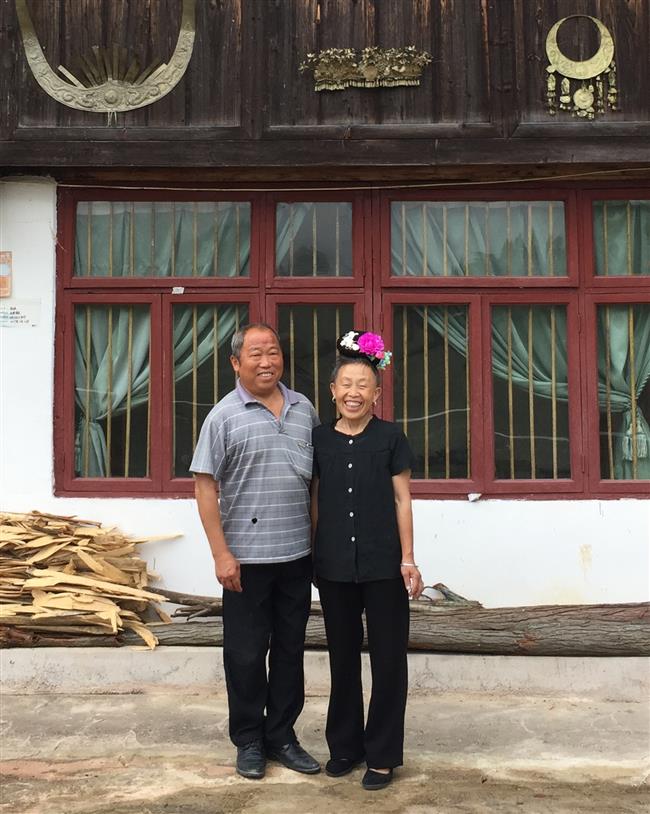
The village chief, Guzangtou, and his wife
If you go:
How to get there: The flight from Shanghai to Guiyang, capital of Guizhou Province, takes about two hours. From there, it’s a 40-minute high-speed rail trip to the city of Kaili, and then a one-hour bus to Xijiang, where rental cars are available for the last leg of the journey.
Tips:
1. Kongbai Village is not a well-trod tourist destination, and visitors are requested to disturb the locals as little as possible and respect their religion and customs.
2. Living conditions in Kongbai are pretty rudimentary. If the accommodation available is too rustic for your tastes, you could stay in a hotel in Xijiang and just take a day trip to Kongbai, which is a one-hour drive away.
3. The weather in Kongbai is changeable and humid. It’s advisable to bring umbrella and outdoor clothing. You might experience four seasons in one day.
4. Many villagers can’t speak Mandarin, but they are very friendly. Don’t be afraid to use body language to communicate with them.
5. The typical Miao cuisine is very spicy and sour. Visitors who can’t stomach hot dishes should bring along some snacks for sustenance.
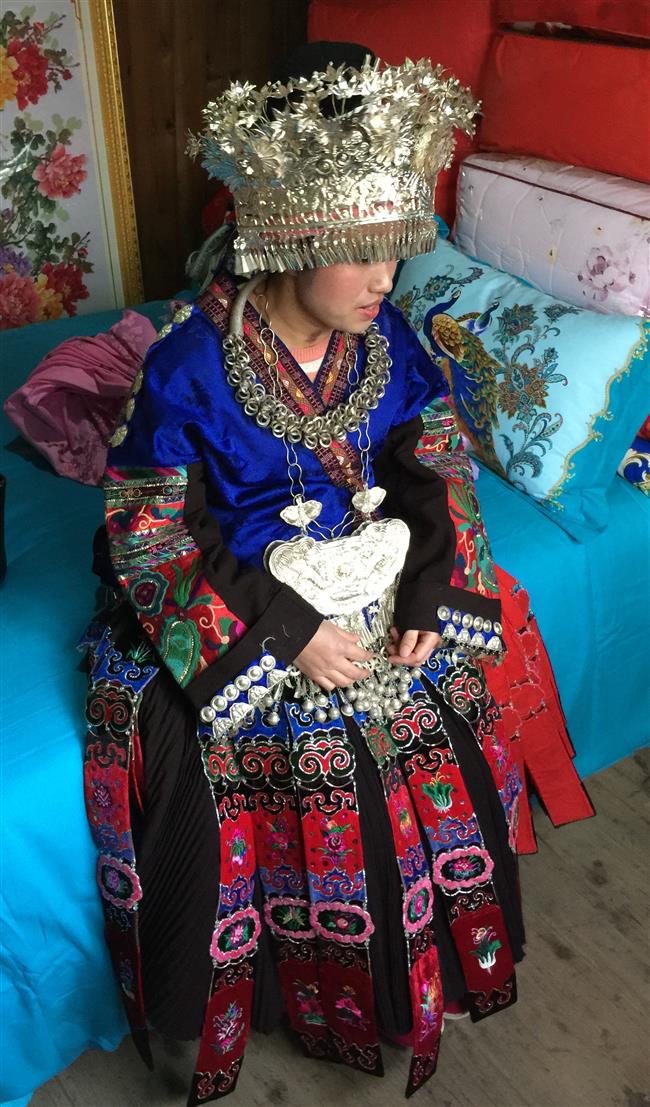
A Miao bride is dressed in an embroidered outfit with dazzling silver ornaments.
Signature silver distinguishes ethnic societies
The Miao ethnic minority is really a series of clans, such as the Black Miao, White Miao, Flowery Miao and Red Miao.
Each has its own dialect, distinctive culture and even specialized styles of silver ornaments.
A full set of Miao silver ornaments generally consists of a silver horn, hairpins, a hat, a comb, necklaces, bracelets, a pair of earrings, waist chain and several garment accessories. The weight of a complete set is about 6 kilograms, which is a lot to carry around, according to silversmiths in Kongbai Village.
Miao silver ornamentation goes beyond just visual decoration. It cuts to the heart of who the Miao people are, reflecting their history, beliefs and traditions.
Except for the silver horn, which can be bequeathed only to a male heir, all other forms of silver ornaments are passed down the matrilineal line.
The silver horn symbolizes a family’s protector and is considered the most precious of silver ornaments. It signifies the buffalo, which is considered a divine animal in Miao culture and is often used in sacrificial rites to honor ancestors.
The butterfly motif is another frequent symbol on silver ornaments. The Miao people identify the butterfly with the origins of humans.
In ancient mythology, the butterfly gave birth to the first man named Jiang Yang and the first woman named Ni Yang, as well as 10 other sacred ancestors including the buffalo, tiger, snake and thunder god.
Other ornamental motives include tung tree blossoms, which “remind” Miao farmers to start plowing in the spring; maple leaves because the tree is believed to be the birthplace of their “mother” butterfly; and the Jiyu bird, which in Miao mythology helped the “mother” butterfly hatch 12 eggs.
Many traditional Chinese patterns can also be found on Miao silver ornaments. Among them is the bat, whose pronunciation in Chinese is a homophone (fu) for the word meaning “good fortune.”
Another is the popular Han pattern of two dragons frolicking with a pearl, which symbolizes the pursuit of happiness.
